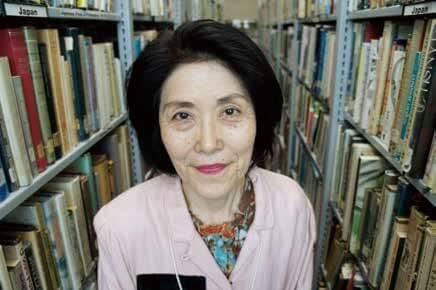Issue:

Swimming a kilometer in her local sports club each day has been just one of the ways Kanako Nakayama has kept herself fit for the demanding job of FCCJ librarian for some 41 years. Nakayamasan, whom both journalists and associate members love and respect, will happily retire on May 31, at the age of 65.
Nakayama graduated from Hirosaki University’s Faculty of Humanities in 1970, and was hired by Hitachi. But two years later, she found an ad in the Asahi Shimbun for the position of FCCJ librarian, and immediately applied for the position. “I love reading books, and communicating in English,” she explained. She was hired by the Club in 1972, and she has worked in the library ever since.
The boundaries of her job stretch beyond the ordinary duties of a librarian. The Club librarian must be able to respond to inquiries, explain the use of databases and wire services. She also helps members get appointments with potential interview subjects, and provides the logistics for our Book Breaks and movie presentations.
One of her talents came in extremely handy for many journalists in the wake of the March 11, 2011 earthquake, tsunami and nuclear disaster her professionally shrewd use of her Tohoku dialect in negotiating with local Fukushima officials.
“When I first made a call to the PTA president of the Okawa Elementary School to try to obtain the contacts of some of the victims, he just barked at me, “We’re too busy! Don’t bother us anymore!” Nakayama said. “But after I spoke to him sympathetically, using my mild Aomori accent, he began to soften his attitude. He finally decided to release the names and addresses for the Club’s journalists.
“For almost a year, my time was completely occupied assisting journalists with their Tohoku coverage. I made all kinds of phone calls, including to Onagawa officials, automotive parts manufacturers and nuclear power plant officials,” she went on.
She admits, however, feeling somewhat guilty of taking advantage of her “mother tongue,” since she left Aomori decades ago, and has made her living in Tokyo using standard Japanese hyojungo.
Helping supervise and support the Library and Movie Committees found her with the added responsibilities of arranging the Book Breaks and, until recently, the movie sneak previews and screenings of old, socially important films.
She cites the successful presentation of the controversial film, The Cove, as an example of the FCCJ’s raison d’être: The FCCJ, where News is Made. The documentary of the killing of dolphins in the quiet cove of Taichi, Wakayama Prefecture, was presented at the Club in 2009, attracting a capacity audience of 230. Both foreign and Japanese media widely covered the killing of the dolphins and the controversial editing of the film. Nakayama stayed neutral and independent in her role as a library professional, despite being repeatedly requested to divulge her personal thoughts.
She has two favorite Book Breaks. One was about The Thames and I, written by Prince Hironomiya, and translated and presented by Sir High Cortazzi in 2006. The audience numbered 140, including a number of British and Japanese diplomats. The other was by Donald Keene on his book in 2011, Chronicles of My Life, which was attended by 210.
Among the unforgettable subjects of searches that Nakayama remembers was the search for WWII veterans. “Most of the old soldiers were over ninety, so it was a race against time.”
Another was the search for small auto parts manufacturers in the Toyota recall case. “The manufacturers insisted that if the interviews went wrong, that they would effectively be hanging them selves,” she said. “But I never give up. I was determined to help the journalists and was finally able to persuade them to accept the interviews.”
Nakayama believes there’s plenty of work remaining in the FCCJ library. “We have very rare clippings, books and photos that have been inherited from our members,” she said. “Some of our reference books on international relations between Asia and Japan date back over 100 years. These must be saved and digitalized for the use of present and future members.”
She pointed out how the historian Manabu Yokohama dug out a document showing Gen. Douglas MacArthur, the Supreme Commander of the Allied Forces of occupied Japan, paying a visit to the Shinto shrine, Kamakura Hachimangu in Sept. 1945 a month after he landed at the Atsugi Airfield as the conqueror of Japan.
Some things have changed, however. “Since member now do a lot of their own researching by internet, the librarians don’t get as many inquiries as in the past,” Nakayama said. “We should arrange to let members use our computers and other facilities. I’d like to even propose expanding the work spaces in the workroom and the library itself, by scrapping unused old books and bookshelves.”
Asking her to stop thinking about the Club library may be difficult. So how will she replace what has been on her agenda for 40 years?
“I would like to spend more time with my 92-year-old mother in Aomori,” she said, smiling. “And I will concentrate on my leadership of the exercise walking group in Koto-ku, where I make my home.”
Haruko Watanabe is former Tokyo Bureau Chief of the Press Foundation of Asia and producer of the “Women Pioneers” video series

